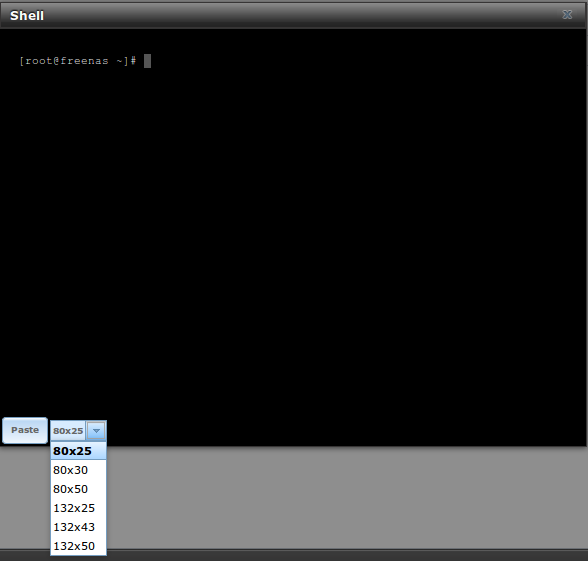18. Shell¶
Beginning with version 8.2.0, the FreeNAS® web interface provides a web shell, making it convenient to run command line tools from the web browser as the root user.

Fig. 18.1 Web Shell
The prompt shows that the current user is root, the hostname is
freenas, and the current working directory is ~, the home
directory of the logged-in user.
Note
The default shell for a new install of FreeNAS® is zsh. FreeNAS® systems which have been upgraded from an earlier version will continue to use csh as the default shell.
The default shell can be changed in . Select the root user and click Modify User. Choose the desired shell from the Shell drop-down and click OK.
To change the size of the shell, click the 80x25 drop-down menu and select a different size.
To copy text from the shell, highlight the text, then right-click and select Copy. Paste text into the shell by clicking Paste, pasting text into the field, and clicking OK.
A history of previous commands is available. Use the up and down arrow
keys to scroll through previously entered commands. Edit the command
if desired, then press Enter to re-enter the command.
The Home, End, and Delete keys are supported.
Tab completion is also available. Type a few letters and press
Tab to complete a command name or filename in the current
directory.
Type exit to leave the session.
Clicking other web interface menus closes the shell session and stops commands running in the shell. tmux provides the ability to detach shell sessions and then reattach to them later. Commands continue to run in a detached session.
Note
Not all shell features render correctly in Chrome. Firefox is the recommended browser when using the shell.
Most FreeBSD command line utilities are available in the Shell, including additional troubleshooting applications for FreeNAS®.